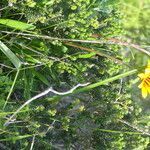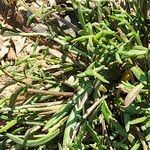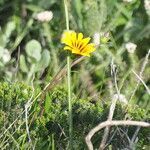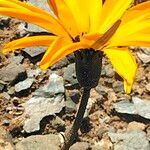Capitula solitary; involucres 10–15 x 6–10 mm., narrowly campanulate to ± obconic, connate for half or more of the length, free parts of the phyllaries 2–3-seriate at the rim of the fused portion, absent from the sides or with a few scattered there; free parts of outer phyllaries strap-shaped, mostly 3–6 mm. long but up to c. 15 mm. long when arising from near the base of the involucre, usually spinose-denticulate on the margins; free parts of inner phyllaries ± triangular, 3–8 mm. long, obtuse or acuminate, the innermost usually with broadly membranous margins.
A herb. It keeps growing from year to year. It lies along the ground. It can be 15 cm high. The leaves are in a clump near the base. They are grey-green. The mature leaves are compound and have 4-6 small narrow lobes on each side. They are rough to touch. They are shiny green on the upper surface and white and woolly underneath. The leaf and stalk can be 17 cm long. The flowers are daisy like. They are on long stalks. The flower stalk contains milky sap. There are a range of colours and they can be striped. The flower heads are 5-6 cm across.
Disk-florets numerous; corollas yellow, 6–10 mm. long, ± shallowly-lobed; achenes 2.5–4 mm. long, narrowly subfusiform-turbinate, obscurely c. 10-ribbed, glandular, densely long-sericeous with the hairs hiding the pappus; pappus 2-seriate of subequal accrescent scale-like setae 4–6 mm. long, the setae developing a somewhat thickened stalk-like base and narrowly hyaline lateral wings which taper into a fine apex, the outer series briefly connate at the base, the inner free.
Leaves few to numerous, densely crowded, all undivided or some pinnatifid, 3–30 x 0.15–0.8 cm., filiform to linear or linear-oblanceolate, narrowly tapering below before widening briefly and ± stem sheathing at the base, acute to subacute, margins ± strongly revolute and barbellate to pilose-ciliate; upper surface glabrescent or sometimes with a few short scattered bristles; lower surface whitish felted-tomentose except for the midrib.
Tufted, acaulescent perennial, up to 200 mm tall. Leaves simple to pinnatisect, white-felted below, glabrous to sparsely echinate and sometimes also cobwebby above. Flowerheads radiate, yellow to orange or rarely red; involucre campanulate, 5-8 mm wide, connate, flat to somewhat intrusive, glabrous to mealy, sometimes glabrescent.
A tufted scapose perennial herb 6–30 cm. tall; rootstock woody with 1-several abbreviated apical underground branches, or stolons bearing leaf tufts, roots numerous fibrous to thong-like.
Tufted, acaulescent perennial to 20 cm. Leaves linear-oblanceolate or pinnatisect, white-felted beneath, margins revolute. Flower heads radiate, yellow to orange; inner bracts acute.
Rays yellow, often with a greenish or reddish band outside, ascending-erect, 14–28 mm. long, linear-oblanceolate or oblanceolate.
Scapes 1-many, 3–18 cm. tall, simple, tomentellous soon glabrescent, naked or with a few linear bracts.
Receptacle shallowly alveolate.




